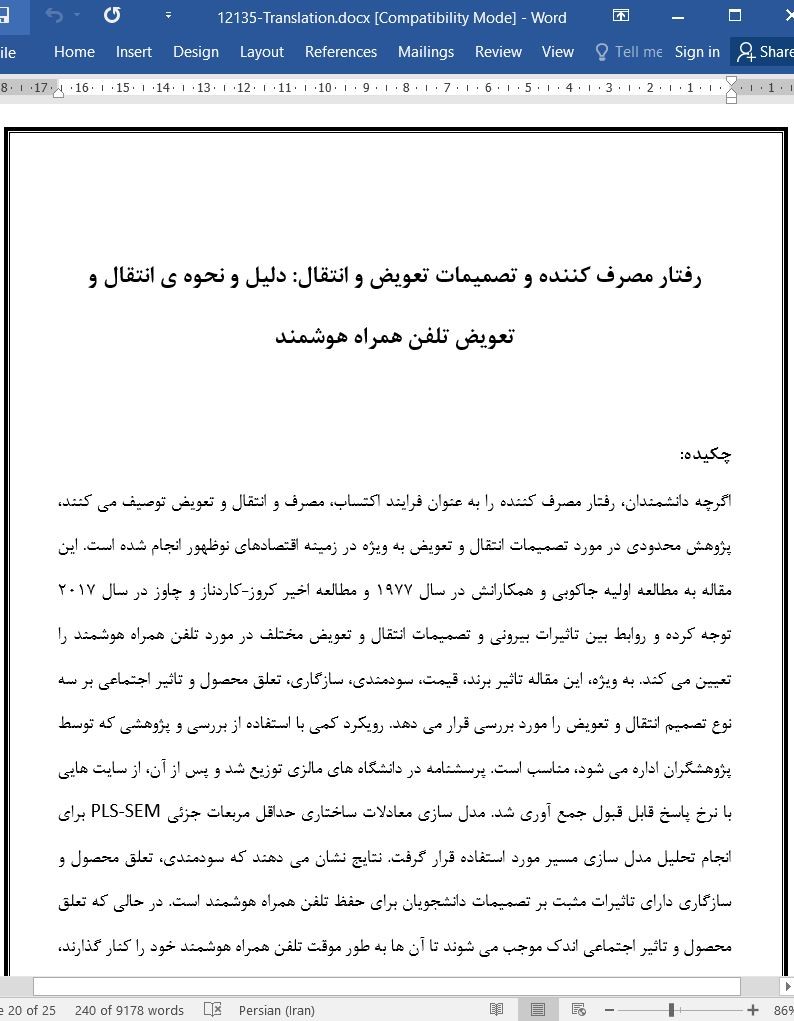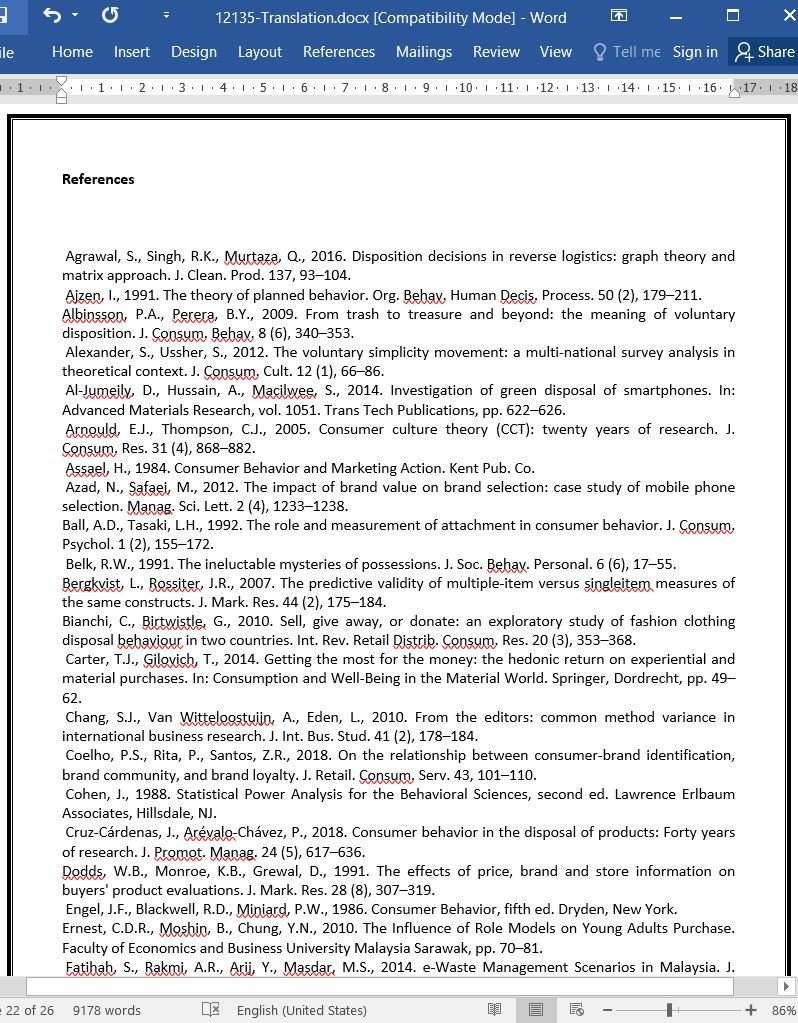
رفتار مصرف کننده و تصمیمات تعویض و انتقال
چکیده
اگرچه دانشمندان، رفتار مصرف کننده را به عنوان فرایند اکتساب، مصرف و انتقال و تعویض توصیف می کنند، پژوهش محدودی در مورد تصمیمات انتقال و تعویض به ویژه در زمینه اقتصادهای نوظهور انجام شده است. این مقاله به مطالعه اولیه جاکوبی و همکارانش در سال 1977 و مطالعه اخیر کروز-کاردناز و چاوز در سال 2017 توجه کرده و روابط بین تاثیرات بیرونی و تصمیمات انتقال و تعویض مختلف در مورد تلفن همراه هوشمند را تعیین می کند. به ویژه، این مقاله تاثیر برند، قیمت، سودمندی، سازگاری، تعلق محصول و تاثیر اجتماعی بر سه نوع تصمیم انتقال و تعویض را مورد بررسی قرار می دهد. رویکرد کمی با استفاده از بررسی و پژوهشی که توسط پژوهشگران اداره می شود، مناسب است. پرسشنامه در دانشگاه های مالزی توزیع شد و پس از آن، از سایت هایی با نرخ پاسخ قابل قبول جمع آوری شد. مدل سازی معادلات ساختاری حداقل مربعات جزئی PLS-SEM برای انجام تحلیل مدل سازی مسیر مورد استفاده قرار گرفت. نتایج نشان می دهند که سودمندی، تعلق محصول و سازگاری دارای تاثیرات مثبت بر تصمیمات دانشجویان برای حفظ تلفن همراه هوشمند است. در حالی که تعلق محصول و تاثیر اجتماعی اندک موجب می شوند تا آن ها به طور موقت تلفن همراه هوشمند خود را کنار گذارند، تنزل و استهلاک ارزش نیز موجب می شود تا آن ها به طور دائم از تلفن همراه هوشمند خود دست بکشند. برند و قیمت هیچ گونه تاثیری بر تصمیمات انتقال و تعویض ندارند، این امر نشان می دهد که کارکرد تلفن همراه هوشمند، به جای خود وسیله، اهمیت بیشتری در تصمیمات انتقال و تعویض دارد. این مطالعه بینش بیشتری را در مورد رفتار مصرف کننده و پیامدهای آن بر مصرف پایدار فراهم می سازد.
1. مقدمه
ارتباطات در همه زمینه های زندگی وجود دارد. بدیهی است، تلفن های همراه هوشمند به عنوان یکی از پرکاربردترین محصولات امروزی ظاهر شده اند. تلفن های همراه هوشمند با انجام چندین کارکرد کامپیوترها و تلفن ها، خدمات ارتباطی را فراهم می سازند (تایچون 2016). مصرف کنندگان در کشورهای توسعه یافته و در حال توسعه، از تلفن های سنتی معمولی به سمت تلفن های همراه هوشمند، در حال تغییر هستند (ونگ 2011). طبق نظر وزارت ارتباطات در سال 2011 و کمیسیون ارتباطات و چندرسانه ای مالزی در سال 2014، کشور مالزی با 144 درصد نفوذ موبایل، از اندونزی، تایلند و حتی ایالات متحده امریکا سبقت گرفته است. مشاهده گنندگان انتظار دارند که این رقم در سال های آینده افزایش یابد، این امر بیانگر اتخاذ و کاربرد بالای تلفن های همراه هوشمند در کشورهای در حال توسعه است.
7. محدودیت ها و مسیرهایی برای مطالعات آینده
با وجود مطالعه اکتشافی با اهداف خاص، در چندین جنبه دارای محدودیت است. ابتدا، نمونه دانشجویان به صورت همگن در نظر گرفته شد، بنابراین تفاوت های بالقوه بین دانشجویان با ویژگی های شخصی و روان شناسی مختلف نادیده گرفته شد. دوم، داشتن دانشجویان دانشگاه به عنوان جمعیت نمونه فقط تعمیم پذیری یافته ها به جمعیت های گسترده تر و سایر بخش های مهم را شکل می دهد. سوم، این مطالعه طرح بخشی و مقطعی را اتخاذ کرده و رفتار حقیقی و تغییر رفتاری هنگام کنار گذاشتن گوشی ها هوشمند را مورد ارزیابی قرار نداد. بر مبنای آن چه که گفته شد، بررسی های آینده در مورد تصمیمات انتقال و تعویض باید ناهمگونی مشاهده شده و مشاهده نشده را در نظر بگیرند. انجام جایگشت و تحلیل گروهی متعدد با استفاده از عوامل جمعیت شناختی مانند جنسیت و وضعیت و موقعیت اجتماعی، می تواند بینش بیشتری را در مورد پدیده مورد نظر ارائه دهد. علاوه براین، مقایسه تصمیمات انتقال و تعویض در بین بخش های مختلف جمعیت و ترکیب عوامل موقعیتی یا روان شناختی به عنوان تعدیل کننده های موجود در مدل ساختاری می تواند توضیح نظری و عملی بیشتری را برای موضوع مورد نظر فراهم سازد. هم چنین انجام مطالعه یا آزمایش طولی در مورد تصمیمات انتقال و تعویض به منظور ارائه نتایجی که برای شاغلین کسب و کار و سایر ذی نفعان مربوطه، دارای معنا و مفهوم است، جالب توجه خواهد بود.
Abstract
Although scholars describe consumer behaviour as a process of acquisition, consumption, and disposition, limited research is done on disposition decisions, especially in the context of emerging economies. This paper looks into the early work of Jacoby et al. (1977) and the recent seminal work of Cruz-Cardenaz and Arevalo-Chavez (2017) to determine the relationships between external influences and various disposition decisions on smartphones. In particular, it investigates the effect of brand, price, usefulness, compatibility, product attachment and social influence on three types of disposition decisions. A quantitative approach using a self-administered survey was appropriated. The questionnaire was distributed at the universities in Malaysia, and was subsequently collected from those sites with an acceptable response rate. Partial least squares structural equation modeling (PLS-SEM) was utilized to perform path modeling analysis. The results show that usefulness, product attachment, and compatibility have positive effects on students’ decisions to keep their smartphones. While low product attachment and social influence affect them to dispose their smartphones temporarily, the depreciation of value causes them to discard smartphones permanently. Remarkably, brand and price have no significant impact on disposition decisions, indicating that the function of the smartphone, rather than the device itself, matters more in disposition decisions. The study thus provides more insights into consumer behaviour and its implications on sustainable consumption.
1. Introduction
Communication is ubiquitous in all walks of life. Evidently, smartphone has emerged as one of today's most widely used products. Smartphones provide communication services by carrying out several functions of computers and telephones (Thaichon et al., 2016). Consumers are changing from ordinary traditional mobile phones to smartphones not only in developed countries but also developing ones (Wong, 2011). According to the Ministry of Communication (2011) and Malaysian Communication and Multimedia Commission (2014), Malaysia, with 144% mobile penetration, outpaces Indonesia, Thailand, and even the United States. Observers expect this figure to further increase in the coming years, suggesting the high adoption and usage of smartphones in developing economies.
7. Limitations and directions of future studies
Notwithstanding an exploratory study with specific objectives, it is limited in several aspects. Firstly, the sample of students was assumed homogenous, thus disregarding the potential differences among students with different personal and psychological characteristics. Secondly, having university students as the target population only will likely compromise the generalizability of the findings to the wider populations and other important segments. Thirdly, the study adopted cross-sectional design and does not measure actual behaviour as well as behavoural change when disposing the smartphones. In light of the aforementioned, future investigations on disposition decisions should take observed and unobserved heterogeneity into consideration. Performing permutation and multi-group analysis using demographic factors, such as gender and social status, could potentially divulge more insights into the phenomenon. Moreover, comparing disposition decisions across different population segments and incorporating psychological or situational factors as moderators in the structural model could also provide more theoretical and practical explanation to the subject matter. It would also be interesting to conduct longitudinal study or experiment on disposition decisions so as to yield results which are more practically meaningful to business practitioners and other relevant stakeholders.
چکیده:
1. مقدمه
2. مروری بر ادبیات
2.1 رفتار انتقال و تعویض
2.2 تصمیمات انتقال و تعویض
2.3 پایه و زیربنای نظری
2.4 توسعه فرضیات
3. متدولوژی پژوهش
4. یافته ها
4.1 ویژگی دموگرافیک و جمعیت شناختی
4.2 ارزیابی مدل اندازه گیری
4.3 ارزیابی مدل ساختاری
5. بحث
6. پیامدها
7. محدودیت ها و مسیرهایی برای مطالعات آینده
منابع
ABSTRACT
1. Introduction
2. Literature review
2.1. Disposition behaviour
2.2. Disposition decisions
2.3. Theoretical underpinning
2.4. Hypothesis development
3. Research methodology
4. Findings
4.1. Demographic profile
4.2. Measurement model assessment
4.3. Assessment of structural model
5. Discussions
6. Implications
7. Limitations and directions of future studies
References
- اصل مقاله انگلیسی با فرمت ورد (word) با قابلیت ویرایش
- ترجمه فارسی مقاله با فرمت ورد (word) با قابلیت ویرایش، بدون آرم سایت ای ترجمه
- ترجمه فارسی مقاله با فرمت pdf، بدون آرم سایت ای ترجمه



